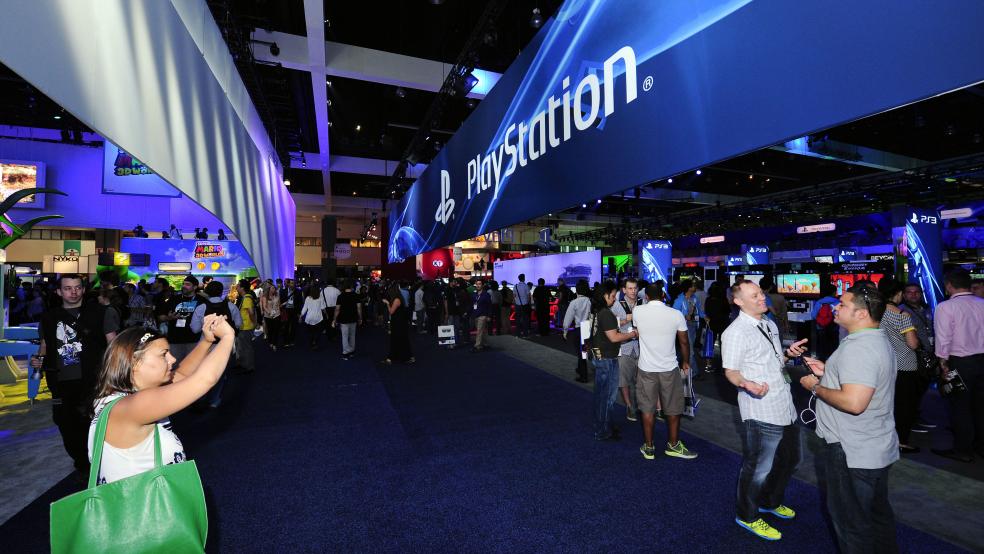The Electronic Entertainment Expo, or E3, is a tricky mistress. Arguably the biggest event in video gaming, this annual show is known for its half-promises, weasel words, and more than a few misleading trailers for games that under-deliver.
Now that another E3 has come and gone, and as convoys of nerds leave Los Angeles — hopefully slightly less pale than when they entered — it’s time to approach the aftermath like an archaeologist approaches a dig site, brushing off the dust and cobwebs in order to find the nuggets of treasure, or Egyptian trinkets. Or whatever. I dunno, I’m not a historian.
Hardware to Handle
The big news from the PlayStation camp was the unveiling of the PlayStation TV. Essentially a stripped down PlayStation Vita sans screen, the PlayStation TV intends to spar toe-to-toe with streaming devices like the Roku, AppleTV, and Amazon TV. However, unlike its competitors, the PlayStation TV allows users to stream games via the Gaikai streaming service (according to Sony, the TV will have a game library replete with titles from the original PlayStation to the present day).
Related: Sony Looks to Strike Indie Gaming Gold at E3 2014
In addition, it will also be compatible with Sony’s new video-streaming service — described by some to be a potential cable-killer — due to roll out later this year. Not bad for the $139 bundle, which also comes along with a controller, a memory card, and a game based off the Lego Movie (woohoo).
Also from Sony comes Project Morpheus, a virtual reality alternative to the crowdfunded Oculus Rift. With skepticism toward the Rift’s after its recent acquisition by Facebook, the Morpheus received lots of extra attention this E3. Journalists were given opportunities to sample the Morpheus in private booths, according to Rolling Stone, which also published a very thorough matchup of the two virtual reality headsets. According to Rolling Stone’s review of the two, the Morpheus came out on top in most categories except for availability, concluding the Morpheus to be the ultimate winner but conceding “The Oculus [Rift] could certainly overtake it, should they invest in cooler games and a more inventive design.”
Don’t count the Rift as completely out yet, though. While the Facebook deal has prompted lots of speculation that the groundbreaking VR headset would become a social marketing tool, the Oculus staff remains adamant that the Rift is a gaming device first and utmost. At E3, Oculus showcased three games, the most interesting of which is called “Super Hot,” a first-person shooter in which time only moves when you move. The prototype version released for the PC has already drawn a great deal of buzz, so it’s going to be really interesting to see how the Rift enhances the experience.
The Big Names
Anticipation has been high for Bungie Studios, the creators of the acclaimed “Halo” series, and their new title, “Destiny.” A sprawling, post-apocalyptic, role-playing game, the project certainly seems ambitious, but if any studio can pull it off, it’s Bungie. This is the studio that created “Marathon” for the Mac — a game years ahead of its time — and pioneered the “Halo” series, piloting it to new heights with every iteration (except with “Halo 3: ODST,” but we don’t talk about that).
Sony also showcased more gameplay of their latest iteration of “The Order: 1886,” their weird shooty-steampunk-werewolf-alternate-history-Victorian-era creation (whew, that’s a lot of adjectives). The premise is ludicrous even by video game standards: the game features an old order of knights who have been tasked with protecting London from half-breed monsters. Though the graphics in the teasers have been impressive, it’s hard to see this game catching on, especially given that the whole steampunk fad seems to have died down a notch.
Related: 21 Titles That Rocked the Video Game Industry
There’s also a new “Halo” game coming out … eventually. Microsoft’s new development team 343 Industries, created after Bungie gave up producing the series, showed the first teaser trailer of the latest sequel in the franchise, titled “Halo 5: Guardians.” Not much more information is available aside from what was presented in the teaser, but you can be sure you’re going to hear a lot more about it leading up to its release.
While Nintendo didn’t actively participate in the traditional stage presentations, that didn’t stop it from teasing a few titles, most of them rehashed milkings of their beloved nostalgic franchises. Luckily, though, the Wii U is able to render titles like the new “Zelda” game (slated for a 2015 release) in beautiful detail. Also due for a release is another iteration of “Super Smash Bros.,” the madcap brawler that draws in characters from Nintendo’s universe and makes them fight each other. This version throws Pac-Man into the ring, so if you want to devour a power pellet and punch Mario in the face, this’ll be the game for you.
The Year of the Re-Release
Amidst the trove of sequels and new titles, a somewhat worrying trend is emerging: the re-release. Rockstar’s record-smashing hit, “Grand Theft Auto V,” originally created for the PS3 and Xbox 360, is being ported to the PC, PlayStation 4, and Xbox One. The same is happening for Naughty Dog’s critical darling, “The Last of Us,” which is getting a remastered edition shipped to current-gen consoles.
Microsoft is getting in on the game too, re-releasing the first four iterations of “Halo” reengineered for the Xbox One. While this announcement in particular seems like they’re milking the series, there’s the hope that the reinvigorated multiplayer might somewhat break the interminable monopoly that the “Call of Duty” franchise has over the multiplayer market.
Related: Why Microsoft’s Xbox One Has Already Lost to Sony’s PS4
Even adventure games of old are getting a nostalgic makeover. Sony announced to rapturous applause that “Grim Fandango,” Tim Schafer’s cartoonishly surreal magnum opus, would be getting a polished version released to the PlayStation platform. As the polished version of “The Secret of Monkey Island” proved, classics can successfully be remade while still remaining true to the original.
Sequels abounded too — some of them long awaited, and others completely unwanted. Ubisoft’s team responsible for “Far Cry 4,” the amorphous game series where the only consistent narrative feature seems to be a murderous antagonist in a far-flung location, showcased the first gameplay for the latest iteration. Though it seems somewhat derivative of the previous game, the graphics are pretty, and the plot seems intriguing enough to cover the fact that every Ubisoft game is essentially the same.
Speaking of treading old ground, tomb-raiding seems to be back in fashion. Square Enix announced the sequel to their Tomb Raider reboot, under the awful moniker of “The Rise of the Tomb Raider,” which was met responses ranging along a spectrum of mild excitement to complete apathy. Critics were more receptive to the teasing of the latest iteration of “Uncharted,” which seems to feature a grizzled, older, more serious incarnation of protagonist Nathan Drake. Usually a youthful wisecracker, it would seem that Naughty Dog has decided to act on criticism that Drake is too one-dimensional a character.
The Hidden Gems
E3 is also a battleground for small indie games, quirky specialized peripherals, and niche titles. Amongst these underdogs lie a few stunning gems:
Razer released the Nabu, a smaller rubberized armband that functions like a cross between a Samsung smartwatch and the Nike FuelBand. Compatible with both iOS and Android (and Windows phone too, natch, since Razer is a Microsoft company), the Nabu handles phone calls, displays important reminders and notifications, and tracks fitness-related activities like walking and climbing stairs. Smartwatches in general are somewhat gimmicky, so hopefully this new entry into the ever-growing pool does enough to innovate and separate itself from its competitors.
PlayDead, the crew that created “Limbo,” the silhouetted, moody, and weirdly violent game from 2010, is back with a new release. “Inside” looks to be a spiritual successor to “Limbo” in almost every way except the palette. That’s a good thing, mind you — “Limbo” was fantastic.
We also saw more of “Hotline Miami 2: Wrong Number.” Devolver Digital shocked with the first “Hotline Miami,” a hyperviolent top-down game set in a romanticized 1980’s neon universe. From what was shown of its successor, it’s more of the same deal in terms of gameplay, with hints of a broader storyline. Hopefully this new version will expand upon the original’s proof-of-concept nature while expanding on some of the shortcomings of the original.
What stood out to you from E3 2014? Tell us below in the comments.
Top Reads From The Fiscal Times:



